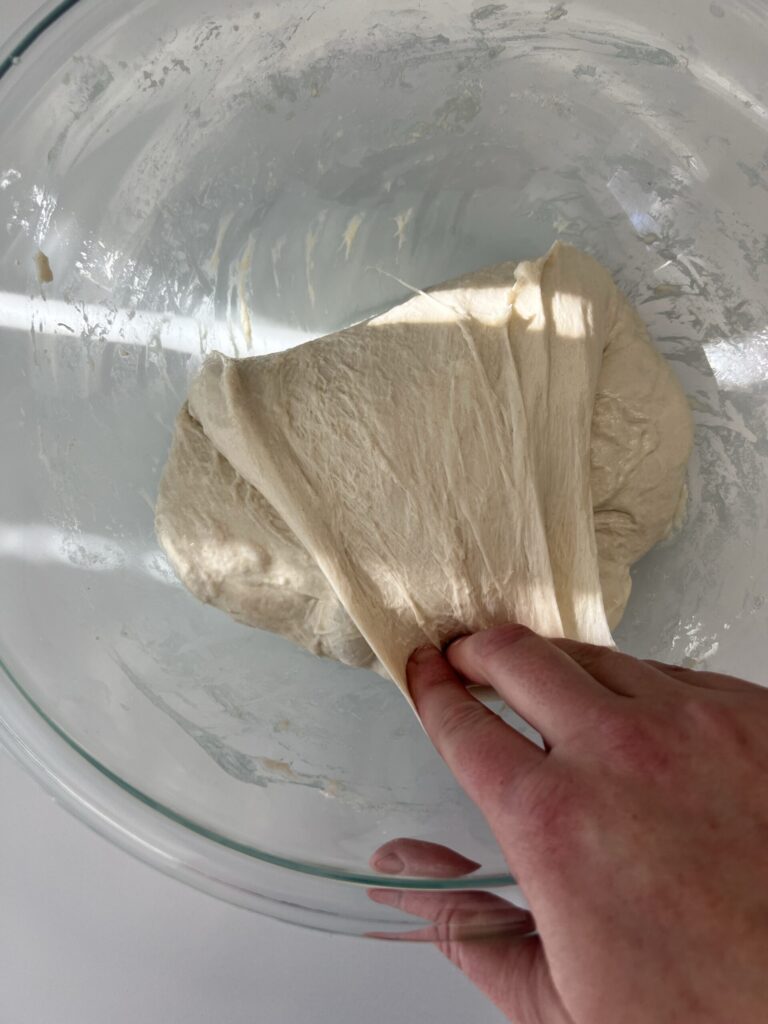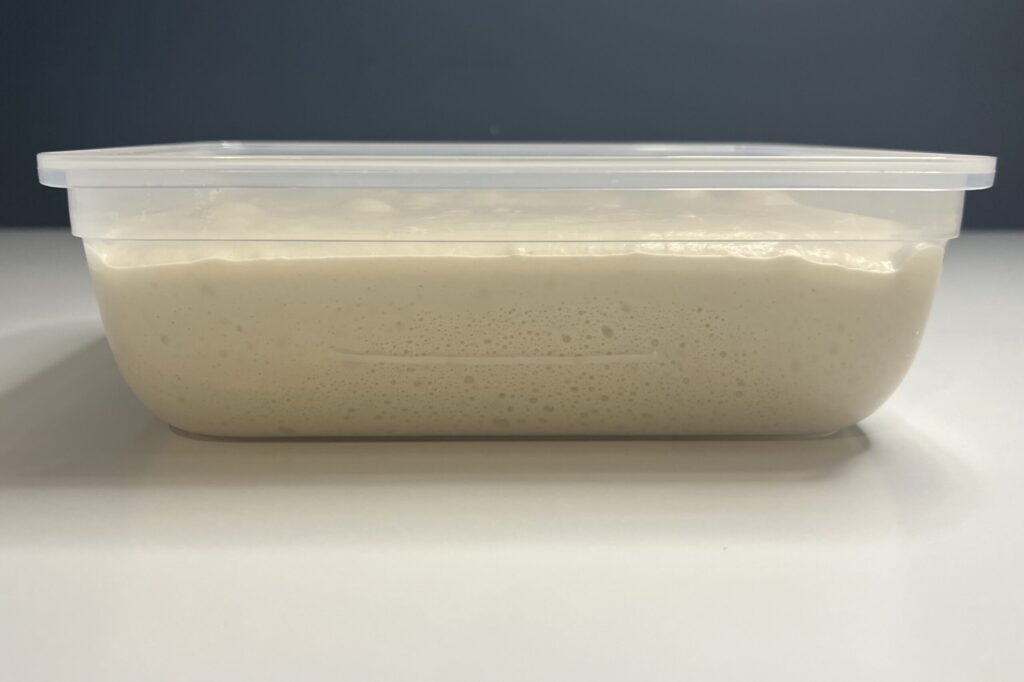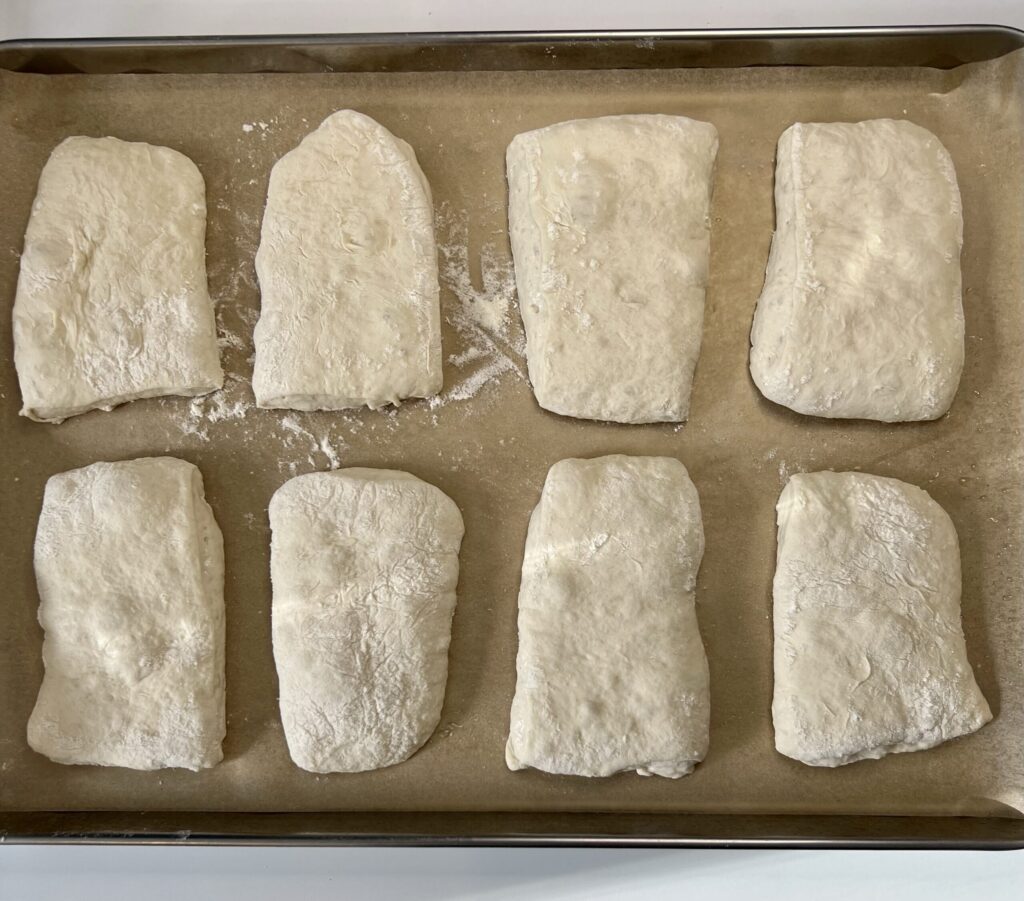This sourdough ciabatta bread recipe is so easy and delicious, you may never want to eat your sandwich any other way! Ciabatta bread is known for having an airy and porous texture with the slightest crispy crust.
In this recipe, I give you the option to lower the hydration just a bit to make it more approachable, but it does not skimp out on ciabatta’s classic texture and flavor. All you need is 4 simple ingredients (flour, water, sourdough starter, & salt) and you’ve got yourself the best homemade, classic ciabatta bread!

What is sourdough ciabatta bread?
The word “ciabatta” means “slipper” in Italian, referring to the bread’s unique shape. Ciabatta is a type of Italian bread that is characterized by its oval shape and airy, porous texture. It is made with a mixture of flour, yeast, salt, and water, and is typically baked in a hot oven to produce a crisp crust. When baking it with a sourdough starter, it takes the place of the yeast. The long fermentation process gives this bread a deeper flavor profile, making it incredible!

Three ways to enjoy your sourdough ciabatta bread
- Toasted with olive oil and balsamic vinegar: Toast slices of ciabatta bread and brush with olive oil. Sprinkle with salt and black pepper, and then drizzle with balsamic vinegar for a simple and delicious snack or appetizer.
- As a sandwich: Use slices of ciabatta bread as the base for a hearty sandwich filled with your favorite ingredients.
- With dips or spreads: Ciabatta bread makes an excellent addition to any dip or spread platter, as its large surface area provides plenty of room for dipping and its porous texture soaks up flavors beautifully. Serve it with hummus, pesto, or bruschetta topping.

Why you’ll love this recipe
- Optional hydration. Typically, sourdough ciabatta bread recipes use 80% or higher hydration, but this one can be modified between 77% and 80%. This makes the dough easier to work with and less intimidating if desired.
- Minimal prep work. The only prep work comes with mixing the dough and a few stretch and folds. Then place it in the refrigerator until ready to bake. You’ll find the steps straightforward & simple.
- Minimal equipment. The only baking equipment required is a baking sheet and parchment paper. Nothing fancy is required!

Tips before baking:
- Sourdough starter: For a successful rise, I recommend feeding your starter 8-12 hours before you plan to mix the dough. For instance, I feed my starter the evening before (7 PM) I plan to mix the dough. I will mix the dough at 7 AM the following morning. You want to use an active, bubbly starter.
- Proofing container: After the dough has been mixed and 4 stretch and folds have been completed, I recommend placing the dough in a rectangular proofing container. This helps with accurately assessing the rise and also allows for easy shaping. I use this one, but any container around 8.5 cups will do. You want the dough to increase by 50-75% in volume.
- Rise times: For the first bulk rise, it took mine about 6 hours to increase a bit more than 75% at 70 degrees F. You may need a few extra hours if it is cooler than this or you may need less time in a warmer environment. Watch the dough, not the clock.

How to make sourdough ciabatta bread: step-by-step
Ingredients & Equipment
- 500 grams of bread flour
- 100 grams active sourdough starter
- 10 grams salt
- 385-400 grams of water (see notes)
- 5 grams of EVOO (optional)
- mixing bowl
- rectangle proofing container
- baking sheet
- parchment paper
- bench scraper
- silicone scraper tool (not required, but handy)
Baker’s schedule: feed your sourdough starter the evening before you mix the dough. Mix the dough early in the morning (8 AM) to bake for the following day.
Hydration: This recipe can be done with 385 grams of water or up to 400 grams. You may want to start with 385 and then work your way up. Either way, the result will be lovely.
Mix the dough
- In a mixing bowl, dissolve the sourdough starter in the water. Stir using a fork.
- Then, add the flour, salt, and olive oil (if using), and mix until the flour has absorbed all the water. This is best achieved with a silicone spatula as the dough will be very wet.
- Cover the bowl with plastic wrap and let it rest for 30 minutes.

Stretch & Folds
- After the dough has rested, work the dough into a ball by folding it into itself a few times. *Tip: wet your hands to avoid the dough from sticking.
- Then, perform your first stretch and fold. Take a portion of the dough, stretch it up a few inches, and fold it to the opposing side. Rotate the bowl and do this to all 4 quadrants of the dough. Once complete, cover the mixture.
- Perform 3 more stretch and folds in 30-minute increments, totaling 4 stretch and folds.



Transfer the dough to the proofing container
- After all 4 stretch and folds have been completed, transfer the dough to your rectangular proofing container. Anything around 8.5 cups will work.
- Mark where the dough sits and cover the dough with plastic wrap.
- Once the dough has increased by 50-75%, cover it and transfer it to the refrigerator for 8-36 hours.
For the dough to increase by 50-75%, it can take anywhere from 5-8 hours depending on the temperature in your home.


Shape the dough
- The following morning, remove the dough from the refrigerator and line a baking sheet with parchment paper. Additionally, spray a little non-stick oil on the parchment paper.
- Liberally flour your work surface and the top of the dough. It is a sticky dough, so don’t be shy about using enough flour.
- Using a silicone scraper tool or silicone spatula gently loosen the sides of the dough from the container.
- Then, invert the container onto the work surface and allow the dough to naturally fall out.

- Sprinkle flour over the entire surface of the dough and gently pat the dough into a 14×9 rectangle.
- Then, using a bench scraper cut the dough into 8 pieces. I draw lines down the dough using flour to help guide me on where to cut.
- Place each piece of dough onto the baking sheet about an inch apart.
- Place each piece of dough onto the baking sheet about an inch apart, sprinkle with a little flour, & cover it with oiled plastic wrap or a large proofing bag. Let them rest for 1-2 hours or until they puff up a bit.



Bake the sourdough ciabatta bread
- When ready to bake, preheat your oven to 475 degrees F and bake for 10 minutes. Reduce the temperature to 450 degrees F and bake for 8-10 minutes more or until the bread starts to brown.

- Remove from the oven and allow the bread to cool for 1 hour before cutting into it & enjoy!

More sourdough recipes to try:
- Soft Sourdough Sandwich Bread (not too tangy!)
- Easy Sourdough Focaccia Bread
- Sourdough Fougasse
- Sourdough French Bread
Sourdough Ciabatta Bread
Equipment
- Mixing bowl
- Baking sheet
- Parchment paper
- Bench scraper
- rectangle proofing container
- Food scale
- Silicone scraper tool optional but handy
Ingredients
- 100 grams active sourdough starter
- 385-400 grams water see notes
- 500 grams bread flour
- 10 grams salt
- 5 grams olive oil (optional)
Instructions
Mix the dough
- In a mixing bowl, dissolve the sourdough starter in the water. Stir using a fork.
- Then, add the flour, salt, and olive oil (if using), and mix until the flour has absorbed all the water. This is best achieved with a silicone spatula as the dough will be very wet.
- Cover the bowl with plastic wrap and let it rest for 30 minutes.
Stretch & Folds
- After the dough has rested, work the dough into a ball by folding it into itself a few times. Tip: wet your hands to avoid the dough from sticking.
- Then, perform your first stretch and fold. Take a portion of the dough, stretch it up a few inches, and fold it to the opposing side. Rotate the bowl and do this to all 4 quadrants of the dough.
- Once complete, cover the mixture.
- Perform 3 more stretch and folds in 30-minute increments.
Transfer the dough to the proofing container
- After all 4 stretch and folds have been completed, transfer the dough to your rectangular proofing container. Anything around 8.5 cups will work.
- Mark where the dough sits and cover the dough with plastic wrap.
- Once the dough has increased in volume by 50-75%, cover it and transfer it to the refrigerator for 8-36 hours.
- For the dough to increase by 50-75%, it can take anywhere from 5-8 hours depending on the temperature in your home. Mine took 6 hours @ 70 degrees F.
Shape the dough
- The following morning, remove the dough from the refrigerator and line a baking sheet with parchment paper. Additionally, spray a little non-stick oil on the parchment paper.
- Liberally flour your work surface and the top of the dough. It is a sticky dough, so don't be shy about using enough flour.
- Using a silicone scraper tool or silicone spatula gently loosen the sides of the dough from the container.
- Then, invert the container onto the work surface and allow the dough to naturally fall out.
- Sprinkle flour over the entire surface of the dough and gently pat the dough into a 14×9 rectangle.
- Then, using a bench scraper cut the dough into 8 pieces. I draw lines down the dough using flour to help guide me on where to cut.
- Place each piece of dough onto the baking sheet about an inch apart, sprinkle with a little flour, & cover it with oiled plastic wrap or a large proofing bag. Let them rest for 1-2 hours or until they puff up a bit.
Bake the sourdough ciabatta bread
- When ready to bake, preheat your oven to 475 degrees F and bake for 10 minutes. Reduce the temperature to 450 degrees F and bake for 8-10 minutes more or until the bread starts to brown.
- Remove from the oven and allow the bread to cool for 1 hour before cutting into it & enjoy!
- Any leftover sourdough ciabatta bread can be stored in an airtight continer or bread bag for 3-4 days on the counter.


Leave a Comment & Rate the Recipe